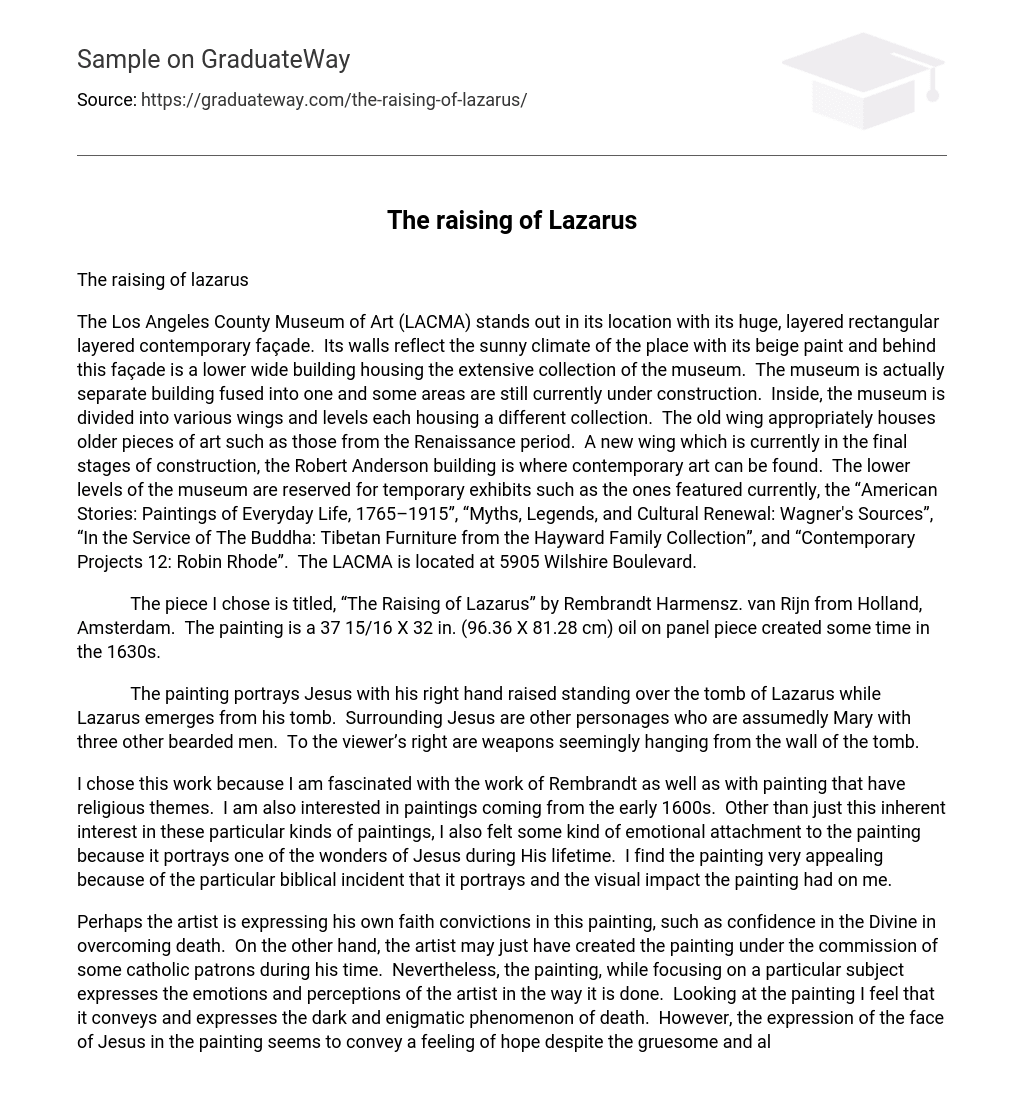The Los Angeles County Museum of Art (LACMA) stands out in its location with its huge, layered rectangular layered contemporary façade. Its walls reflect the sunny climate of the place with its beige paint and behind this façade is a lower wide building housing the extensive collection of the museum. The museum is actually separate building fused into one and some areas are still currently under construction. Inside, the museum is divided into various wings and levels each housing a different collection. The old wing appropriately houses older pieces of art such as those from the Renaissance period. A new wing which is currently in the final stages of construction, the Robert Anderson building is where contemporary art can be found. The lower levels of the museum are reserved for temporary exhibits such as the ones featured currently, the “American Stories: Paintings of Everyday Life, 1765–1915”, “Myths, Legends, and Cultural Renewal: Wagner’s Sources”, “In the Service of The Buddha: Tibetan Furniture from the Hayward Family Collection”, and “Contemporary Projects 12: Robin Rhode”. The LACMA is located at 5905 Wilshire Boulevard.
The piece I chose is titled, “The Raising of Lazarus” by Rembrandt Harmensz. van Rijn from Holland, Amsterdam. The painting is a 37 15/16 X 32 in. (96.36 X 81.28 cm) oil on panel piece created some time in the 1630s.
The painting portrays Jesus with his right hand raised standing over the tomb of Lazarus while Lazarus emerges from his tomb. Surrounding Jesus are other personages who are assumedly Mary with three other bearded men. To the viewer’s right are weapons seemingly hanging from the wall of the tomb.
I chose this work because I am fascinated with the work of Rembrandt as well as with painting that have religious themes. I am also interested in paintings coming from the early 1600s. Other than just this inherent interest in these particular kinds of paintings, I also felt some kind of emotional attachment to the painting because it portrays one of the wonders of Jesus during His lifetime. I find the painting very appealing because of the particular biblical incident that it portrays and the visual impact the painting had on me.
Perhaps the artist is expressing his own faith convictions in this painting, such as confidence in the Divine in overcoming death. On the other hand, the artist may just have created the painting under the commission of some catholic patrons during his time. Nevertheless, the painting, while focusing on a particular subject expresses the emotions and perceptions of the artist in the way it is done. Looking at the painting I feel that it conveys and expresses the dark and enigmatic phenomenon of death. However, the expression of the face of Jesus in the painting seems to convey a feeling of hope despite the gruesome and almost scary expression on the face of Lazarus. The expression on the faces of the other spectators reflect the same awe that I feel for the painting; while the subjects express an awe at the wonder that Jesus performed, I am awed at how detailed and visually stimulating the painting still is centuries after it was created.
The painting features dark and subdued colors such as blacks, brows, and deep reds, perhaps to effectively convey the atmosphere within the tomb. What is noticeable in the painting is the stark and painstaking attention to detail of the subjects set against the blurred background. This works to effectively give the subjects dimension like they were popping out of the panel. Light is used sparingly in this painting, as shown in the minimal light filtering in through the opening of the tomb, to express the encroachment of this element into the darkness of the tomb. The lines between the subjects and the background are blurred giving the illusion that everything bleeds into one another and concealing the distinctive boundaries between each element. The painting, by blurring some of the elements, also give the illusion of depth and how the darkness is able to embrace some of the subjects such as the little boy directly in front of Jesus. The arrangement of the subjects in the painting are done in such that the painting is heavier on the viewers left where there are more elements that in the viewers right where the only subject featured is the rising Lazarus. Perhaps the artist intended it to be this way to focus attention on Lazarus, who is, after all, the main event in the painting. Putting Jesus in an area where there are other people also diminishes the focus on this particular element because if this was not done, the Jesus element would probably grab the attention that was intended for Lazarus. The interesting aspect of this painting is the weapons hanging in the tomb in the viewer’s upper right. While it was normal during this period to bury the possessions of the dead with them, these implements contain some kind of symbolism, perhaps related to man’s struggle against death, or man’s struggle with the darkness of despair. In was drawn to this painting in particular because of the contrast offered between light and dark, not only in the colors and the style of the painting, but in how the artist was able to translate these artistic elements into the substantial contrast of the theme; light and dark, life and death. In effect, the artist was able to express the subject effectively because of artistic technique and the use of artistic elements that worked together to convey the emotions of the theme.





